| Listing 1 - 10 of 12 | << page >> |
Sort by
|

ISBN: 076195161X Year: 2001 Publisher: London Sage
Abstract | Keywords | Export | Availability | Bookmark
 Loading...
Loading...Choose an application
- Reference Manager
- EndNote
- RefWorks (Direct export to RefWorks)
#SBIB:303H520 --- regressie-analyse --- wiskundige statistiek --- Methoden sociale wetenschappen: techniek van de analyse, algemeen --- Analysis of covariance. --- Analysis of variance. --- Analysis of covariance --- Analysis of variance --- ANOVA (Analysis of variance) --- Variance analysis --- Mathematical statistics --- Experimental design --- Covariance analysis --- Regression analysis

ISBN: 1280369302 9786610369300 1412933358 9781412933353 9780761951605 0761951601 9780761951612 076195161X 0761951601 076195161X Year: 2000 Publisher: London : SAGE Publications,
Abstract | Keywords | Export | Availability | Bookmark
 Loading...
Loading...Choose an application
- Reference Manager
- EndNote
- RefWorks (Direct export to RefWorks)
Traditional approaches to ANOVA and ANCOVA are now being replaced by a General Linear Modeling (GLM) approach. This book begins with a brief history of the separate development of ANOVA and regression analyses and demonstrates how both analysis forms are subsumed by the General Linear Model. A simple single independent factor ANOVA is analysed first in conventional terms and then again in GLM terms to illustrate the two approaches. The text then goes on to cover the main designs, both independent and related ANOVA and ANCOVA, single and multi-factor designs. The conventional
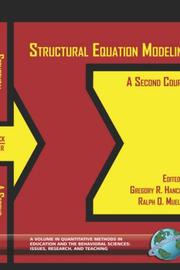
ISBN: 1281378763 9786611378769 1607527618 9781607527619 9781593110154 1593110154 9781593110147 1593110146 Year: 2006 Publisher: Greenwich, Conn. IAP
Abstract | Keywords | Export | Availability | Bookmark
 Loading...
Loading...Choose an application
- Reference Manager
- EndNote
- RefWorks (Direct export to RefWorks)
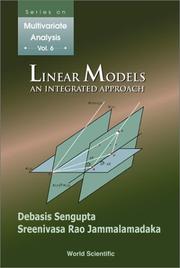
ISBN: 1281347752 9786611347758 981256490X 9789812564900 9789810245924 9810245920 9810245920 Year: 2003 Volume: 6 Publisher: River Edge, N.J. : World Scientific,
Abstract | Keywords | Export | Availability | Bookmark
 Loading...
Loading...Choose an application
- Reference Manager
- EndNote
- RefWorks (Direct export to RefWorks)
Linear Models: An Integrated Approach aims to provide a clearand deep understanding of the general linear model using simplestatistical ideas. Elegant geometric arguments are also invoked asneeded and a review of vector spaces and matrices is provided to makethe treatment self-contained.
Linear models (Statistics) --- Analysis of covariance. --- Regression analysis. --- Analysis, Regression --- Linear regression --- Regression modeling --- Multivariate analysis --- Structural equation modeling --- Covariance analysis --- Regression analysis --- Models, Linear (Statistics) --- Mathematical models --- Mathematical statistics --- Statistics --- Modèles linéaires (Statistique)
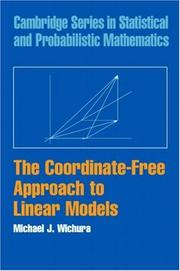
ISBN: 0521868424 9780521868426 9780511546822 9780511349867 0511349866 0511546823 1107171016 1281085936 9786611085933 1139132423 0511350767 0511348010 0511348983 Year: 2006 Publisher: Cambridge : Cambridge University Press,
Abstract | Keywords | Export | Availability | Bookmark
 Loading...
Loading...Choose an application
- Reference Manager
- EndNote
- RefWorks (Direct export to RefWorks)
This book is about the coordinate-free, or geometric, approach to the theory of linear models; more precisely, Model I ANOVA and linear regression models with non-random predictors in a finite-dimensional setting. This approach is more insightful, more elegant, more direct, and simpler than the more common matrix approach to linear regression, analysis of variance, and analysis of covariance models in statistics. The book discusses the intuition behind and optimal properties of various methods of estimating and testing hypotheses about unknown parameters in the models. Topics covered range from linear algebra, such as inner product spaces, orthogonal projections, book orthogonal spaces, Tjur experimental designs, basic distribution theory, the geometric version of the Gauss-Markov theorem, optimal and non-optimal properties of Gauss-Markov, Bayes, and shrinkage estimators under assumption of normality, the optimal properties of F-test, and the analysis of covariance and missing observations.
Linear models (Statistics) --- Analysis of variance --- Regression Analysis --- Analysis of covariance --- Analysis of variance. --- Regression analysis. --- Analysis of covariance. --- Covariance analysis --- Regression analysis --- Analysis, Regression --- Linear regression --- Regression modeling --- Multivariate analysis --- Structural equation modeling --- ANOVA (Analysis of variance) --- Variance analysis --- Mathematical statistics --- Experimental design --- Models, Linear (Statistics) --- Mathematical models --- Statistics --- Mathematical Sciences --- Probability
Book
ISBN: 1623962463 9781623962463 9781623962449 1623962447 9781623962456 1623962455 Year: 2013 Publisher: Charlotte, N.C. : Information Age Pub.,
Abstract | Keywords | Export | Availability | Bookmark
 Loading...
Loading...Choose an application
- Reference Manager
- EndNote
- RefWorks (Direct export to RefWorks)
Structural equation modeling. --- Analysis of covariance. --- Linear models (Statistics) --- Multilevel models (Statistics) --- Hierarchical linear models (Statistics) --- Mixed effects models (Statistics) --- Random coefficient models (Statistics) --- Variance component models (Statistics) --- Mathematical models --- Regression analysis --- Models, Linear (Statistics) --- Mathematical statistics --- Statistics --- Covariance analysis --- SEM (Structural equation modeling) --- Multivariate analysis --- Factor analysis --- Path analysis (Statistics) --- Structural equation modeling --- Analysis of covariance
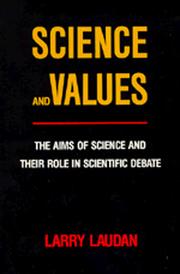
ISBN: 1282383000 9786612383007 0520908112 9780520908116 0520052676 9780520052673 0520057430 9780520057432 Year: 1984 Publisher: Berkeley : University of California Press,
Abstract | Keywords | Export | Availability | Bookmark
 Loading...
Loading...Choose an application
- Reference Manager
- EndNote
- RefWorks (Direct export to RefWorks)
Laudan constructs a fresh approach to a longtime problem for the philosopher of science: how to explain the simultaneous and widespread presence of both agreement and disagreement in science. Laudan critiques the logical empiricists and the post-positivists as he stresses the need for centrality and values and the interdependence of values, methods, and facts as prerequisites to solving the problems of consensus and dissent in science.
Science --- Philosophy. --- cognitive values. --- consensus. --- covariance fallacy. --- decision making. --- dissent. --- empirical evidence. --- empiricism. --- ethics. --- goal evaluation. --- kuhn. --- logic. --- methodology. --- natural sciences. --- nonfiction. --- philosophy of science. --- philosophy. --- post positivism. --- realist axiology. --- research. --- reticulated model. --- science and technology. --- science. --- scientific change. --- scientific community. --- scientific debate. --- scientific knowledge. --- scientific method. --- scientific rationality. --- scientific revolutions.
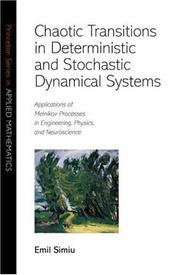
ISBN: 0691050945 1400832500 9781400832507 9780691144344 0691144346 9780691144344 9780691050942 Year: 2002 Publisher: Princeton, New Jersey : Princeton University Press,
Abstract | Keywords | Export | Availability | Bookmark
 Loading...
Loading...Choose an application
- Reference Manager
- EndNote
- RefWorks (Direct export to RefWorks)
The classical Melnikov method provides information on the behavior of deterministic planar systems that may exhibit transitions, i.e. escapes from and captures into preferred regions of phase space. This book develops a unified treatment of deterministic and stochastic systems that extends the applicability of the Melnikov method to physically realizable stochastic planar systems with additive, state-dependent, white, colored, or dichotomous noise. The extended Melnikov method yields the novel result that motions with transitions are chaotic regardless of whether the excitation is deterministic or stochastic. It explains the role in the occurrence of transitions of the characteristics of the system and its deterministic or stochastic excitation, and is a powerful modeling and identification tool. The book is designed primarily for readers interested in applications. The level of preparation required corresponds to the equivalent of a first-year graduate course in applied mathematics. No previous exposure to dynamical systems theory or the theory of stochastic processes is required. The theoretical prerequisites and developments are presented in the first part of the book. The second part of the book is devoted to applications, ranging from physics to mechanical engineering, naval architecture, oceanography, nonlinear control, stochastic resonance, and neurophysiology.
Differentiable dynamical systems. --- Chaotic behavior in systems. --- Stochastic systems. --- Systems, Stochastic --- Stochastic processes --- System analysis --- Chaos in systems --- Chaos theory --- Chaotic motion in systems --- Differentiable dynamical systems --- Dynamics --- Nonlinear theories --- System theory --- Differential dynamical systems --- Dynamical systems, Differentiable --- Dynamics, Differentiable --- Differential equations --- Global analysis (Mathematics) --- Topological dynamics --- Affine transformation. --- Amplitude. --- Arbitrarily large. --- Attractor. --- Autocovariance. --- Big O notation. --- Central limit theorem. --- Change of variables. --- Chaos theory. --- Coefficient of variation. --- Compound Probability. --- Computational problem. --- Control theory. --- Convolution. --- Coriolis force. --- Correlation coefficient. --- Covariance function. --- Cross-covariance. --- Cumulative distribution function. --- Cutoff frequency. --- Deformation (mechanics). --- Derivative. --- Deterministic system. --- Diagram (category theory). --- Diffeomorphism. --- Differential equation. --- Dirac delta function. --- Discriminant. --- Dissipation. --- Dissipative system. --- Dynamical system. --- Eigenvalues and eigenvectors. --- Equations of motion. --- Even and odd functions. --- Excitation (magnetic). --- Exponential decay. --- Extreme value theory. --- Flow velocity. --- Fluid dynamics. --- Forcing (recursion theory). --- Fourier series. --- Fourier transform. --- Fractal dimension. --- Frequency domain. --- Gaussian noise. --- Gaussian process. --- Harmonic analysis. --- Harmonic function. --- Heteroclinic orbit. --- Homeomorphism. --- Homoclinic orbit. --- Hyperbolic point. --- Inference. --- Initial condition. --- Instability. --- Integrable system. --- Invariant manifold. --- Iteration. --- Joint probability distribution. --- LTI system theory. --- Limit cycle. --- Linear differential equation. --- Logistic map. --- Marginal distribution. --- Moduli (physics). --- Multiplicative noise. --- Noise (electronics). --- Nonlinear control. --- Nonlinear system. --- Ornstein–Uhlenbeck process. --- Oscillation. --- Parameter space. --- Parameter. --- Partial differential equation. --- Perturbation function. --- Phase plane. --- Phase space. --- Poisson distribution. --- Probability density function. --- Probability distribution. --- Probability theory. --- Probability. --- Production–possibility frontier. --- Relative velocity. --- Scale factor. --- Shear stress. --- Spectral density. --- Spectral gap. --- Standard deviation. --- Stochastic process. --- Stochastic resonance. --- Stochastic. --- Stream function. --- Surface stress. --- Symbolic dynamics. --- The Signal and the Noise. --- Topological conjugacy. --- Transfer function. --- Variance. --- Vorticity.
Book
ISBN: 0716715945 0716715937 0716717042 9780716715948 9780716717041 Year: 1984 Publisher: New York (N.Y.) Freeman
Abstract | Keywords | Export | Availability | Bookmark
 Loading...
Loading...Choose an application
- Reference Manager
- EndNote
- RefWorks (Direct export to RefWorks)
Mathematical statistics --- Regression analysis --- Correlation (Statistics) --- Analyse de régression --- Corrélation (Statistique) --- Statistics as Topic. --- Regression Analysis. --- 519.235 --- 519.233.5 --- 57.087.1 --- Analysis, Regression --- Regression Diagnostics --- Statistical Regression --- Analyses, Regression --- Diagnostics, Regression --- Regression Analyses --- Regression, Statistical --- Regressions, Statistical --- Statistical Regressions --- Area Analysis --- Correlation Studies --- Correlation Study --- Correlation of Data --- Data Analysis --- Estimation Technics --- Estimation Techniques --- Indirect Estimation Technics --- Indirect Estimation Techniques --- Multiple Classification Analysis --- Service Statistics --- Statistical Study --- Statistics, Service --- Tables and Charts as Topic --- Analyses, Area --- Analyses, Data --- Analyses, Multiple Classification --- Analysis, Area --- Analysis, Data --- Analysis, Multiple Classification --- Area Analyses --- Classification Analyses, Multiple --- Classification Analysis, Multiple --- Data Analyses --- Data Correlation --- Data Correlations --- Estimation Technic --- Estimation Technic, Indirect --- Estimation Technics, Indirect --- Estimation Technique --- Estimation Technique, Indirect --- Estimation Techniques, Indirect --- Indirect Estimation Technic --- Indirect Estimation Technique --- Multiple Classification Analyses --- Statistical Studies --- Studies, Correlation --- Studies, Statistical --- Study, Correlation --- Study, Statistical --- Technic, Estimation --- Technic, Indirect Estimation --- Technics, Estimation --- Technics, Indirect Estimation --- Technique, Estimation --- Technique, Indirect Estimation --- Techniques, Estimation --- Techniques, Indirect Estimation --- Statistics of dependent variables. Contingency tables --- Correlation analysis. Regression analysis --- Biometry. Statistical study and treatment of biological data --- Analysis of variance. --- Psychometrics. --- Regression analysis. --- Correlation (Statistics). --- 57.087.1 Biometry. Statistical study and treatment of biological data --- 519.233.5 Correlation analysis. Regression analysis --- 519.235 Statistics of dependent variables. Contingency tables --- Analyse de régression --- Corrélation (Statistique) --- Numerical approximation theory --- ANALYSIS OF VARIANCE --- PSYCHOMETRICS --- Analysis of Variance. --- 519.233.4 --- Psychometric --- Analysis, Variance --- Variance Analysis --- ANOVA --- Analyses, Variance --- Variance Analyses --- Variance analysis. Covariance analysis --- 519.233.4 Variance analysis. Covariance analysis --- Analysis of variance --- Psychometrics --- Linear regression --- Regression modeling --- Multivariate analysis --- Structural equation modeling --- Measurement, Mental --- Measurement, Psychological --- Psychological measurement --- Psychological scaling --- Psychological statistics --- Psychology --- Psychometry (Psychophysics) --- Scaling, Psychological --- Psychological tests --- Scaling (Social sciences) --- ANOVA (Analysis of variance) --- Variance analysis --- Experimental design --- Statistics as Topic --- Measurement --- Scaling --- Methodology --- Regression Analysis --- Least squares --- Probabilities --- Statistics --- Instrumental variables (Statistics) --- Graphic methods --- Analysis of Variance

ISBN: 9780691096278 0691096279 9786612087592 1400825105 1282087592 1400814243 9781400814244 9781400825103 Year: 2002 Publisher: Princeton, N.J. : Princeton University Press,
Abstract | Keywords | Export | Availability | Bookmark
 Loading...
Loading...Choose an application
- Reference Manager
- EndNote
- RefWorks (Direct export to RefWorks)
The modeling of stochastic dependence is fundamental for understanding random systems evolving in time. When measured through linear correlation, many of these systems exhibit a slow correlation decay--a phenomenon often referred to as long-memory or long-range dependence. An example of this is the absolute returns of equity data in finance. Selfsimilar stochastic processes (particularly fractional Brownian motion) have long been postulated as a means to model this behavior, and the concept of selfsimilarity for a stochastic process is now proving to be extraordinarily useful. Selfsimilarity translates into the equality in distribution between the process under a linear time change and the same process properly scaled in space, a simple scaling property that yields a remarkably rich theory with far-flung applications. After a short historical overview, this book describes the current state of knowledge about selfsimilar processes and their applications. Concepts, definitions and basic properties are emphasized, giving the reader a road map of the realm of selfsimilarity that allows for further exploration. Such topics as noncentral limit theory, long-range dependence, and operator selfsimilarity are covered alongside statistical estimation, simulation, sample path properties, and stochastic differential equations driven by selfsimilar processes. Numerous references point the reader to current applications. Though the text uses the mathematical language of the theory of stochastic processes, researchers and end-users from such diverse fields as mathematics, physics, biology, telecommunications, finance, econometrics, and environmental science will find it an ideal entry point for studying the already extensive theory and applications of selfsimilarity.
Self-similar processes. --- Distribution (Probability theory) --- Processus autosimilaires --- Distribution (Théorie des probabilités) --- 519.218 --- Self-similar processes --- 519.24 --- Distribution functions --- Frequency distribution --- Characteristic functions --- Probabilities --- Selfsimilar processes --- Stochastic processes --- Special stochastic processes --- 519.218 Special stochastic processes --- Distribution (Théorie des probabilités) --- Almost surely. --- Approximation. --- Asymptotic analysis. --- Autocorrelation. --- Autoregressive conditional heteroskedasticity. --- Autoregressive–moving-average model. --- Availability. --- Benoit Mandelbrot. --- Brownian motion. --- Central limit theorem. --- Change of variables. --- Computational problem. --- Confidence interval. --- Correlogram. --- Covariance matrix. --- Data analysis. --- Data set. --- Determination. --- Fixed point (mathematics). --- Foreign exchange market. --- Fractional Brownian motion. --- Function (mathematics). --- Gaussian process. --- Heavy-tailed distribution. --- Heuristic method. --- High frequency. --- Inference. --- Infimum and supremum. --- Instance (computer science). --- Internet traffic. --- Joint probability distribution. --- Likelihood function. --- Limit (mathematics). --- Linear regression. --- Log–log plot. --- Marginal distribution. --- Mathematica. --- Mathematical finance. --- Mathematics. --- Methodology. --- Mixture model. --- Model selection. --- Normal distribution. --- Parametric model. --- Power law. --- Probability theory. --- Publication. --- Random variable. --- Regime. --- Renormalization. --- Result. --- Riemann sum. --- Self-similar process. --- Self-similarity. --- Simulation. --- Smoothness. --- Spectral density. --- Square root. --- Stable distribution. --- Stable process. --- Stationary process. --- Stationary sequence. --- Statistical inference. --- Statistical physics. --- Statistics. --- Stochastic calculus. --- Stochastic process. --- Technology. --- Telecommunication. --- Textbook. --- Theorem. --- Time series. --- Variance. --- Wavelet. --- Website.
| Listing 1 - 10 of 12 | << page >> |
Sort by
|

 Search
Search Feedback
Feedback About
About Help
Help News
News